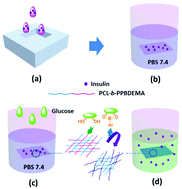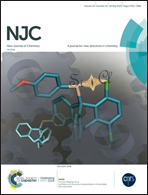Fabrication of glucose-responsive and biodegradable copolymer membrane for controlled release of insulin at physiological pH†
Abstract
A glucose-responsive and biodegradable copolymer, poly(ε-caprolactone)-b-poly(2-phenylboronic ester-1,3-dioxane-5-ethyl)methylacrylate (PCL-b-PPBDEMA), was synthesized by the combination of ring-opening polymerization (ROP) and atom transfer radical polymerization (ATRP). The diblock copolymer could be easily prepared as a membrane containing insulin via a solution casting approach. The crystalline behaviour and thermal properties were investigated by POM and DSC. The results indicated that the PPBDEMA segments could destroy the crystallizability of the PCL segments. Glucose molecules could react with PPBDEMA, which led to the breakage of the phenylboronic acid molecules from the PBDEMA groups. PCL-b-PPBDEMA copolymer membranes as intelligent carriers could realize controlled insulin release via adjusting the glucose concentration. At the physiological pH, the membrane revealed a higher release rate of insulin after immersion in glucose solutions with high concentrations than that in glucose solutions with lower concentrations. In vitro cytotoxicity assays showed that the membrane is almost noncytotoxic.



 Please wait while we load your content...
Please wait while we load your content...